
by DGR News Service | Aug 21, 2024 | ACTION, Biodiversity & Habitat Destruction, The Problem: Civilization
Editor’s note: Mass media news about war raises concerns about death, injury, and refuge of humans, the war on nature is rarely highlighted. But warfare always means ecocide on a large scale and wildlife and nature often take more time to recover than it is capable of. In Ukraine, 80% of wildlife is already on the brink of extinction, with the Russian aggression even more species and individual animals are getting lost. Therefore it’s a relief to have organisations like UAnimals who rescue pets and wildlife in emergency situations and raise international awareness about the destruction in nature and national parks.
The Ottawa Convention also referred to as the “Mine Ban Treaty,” prohibits the use, stockpiling, production, and transfer of anti-personnel landmines (APLs). Some key current and past producers and users of landmines, including the United States, China, India, Pakistan, and Russia, have not signed the treaty.
By John R. Platt/The Revelator
For Ukrainian activists, rescuing the dogs of war — not to mention the cats, swans, bats, bears and other wildlife — often means putting their own lives on the line.
Saving Ukraine’s injured and displaced animals during wartime often means seeing the worst elements of Russian cruelty.
“When a territory is liberated, our team goes there and we speak with the people who survived the occupation,” says Olga Chevhanyuk, chief operating officer of UAnimals, Ukraine’s largest animal-rights organization. “And each time we hear that when the Russians entered the town, they started shooting animals for fun, starting with dogs just walking the streets and ending with huge farms and shelters. Sometimes it’s probably a matter of manipulation, getting people scared. But mostly it’s no reason at all, just because they can.”
Originally founded to oppose inhumane conditions in circuses, the nonprofit UAnimals has shifted its mission to rescuing and caring for domestic animals and wildlife devastated by Russian aggression.
Working with local volunteers and shelters, they’ve helped tens of thousands of animals since the war began a year ago, including dogs and cats, horses, deer, swans, birds of prey and bats — even large predators like bears. In January alone they rescued more than 9,600 animals, provided food and medicine to thousands more, rebuilt shelters, and helped fund operations throughout the country.
They’ve also found themselves purchasing supplies not traditionally used in animal rescues.
“Before the war, you never think of buying helmets for your team,” Chevhanyuk says.
And then there’s the human toll: The nonprofit has contracted with psychologists to provide on-demand assistance to its team in the field. “So now they can have a session with the psychologist when they’re overwhelmed,” she says.
But this is all about saving more than individual animal lives and human minds. It’s about saving the soul of a country.
A Crime Against Nature
UAnimals has started calling the Russian war an ecocide — the deliberate destruction of the natural environment.
“Nowadays 20% of Ukraine’s nature conservation areas are affected by war,” Chevhanyuk says. “Russians occupy eight national reserves and 12 national parks, and some of the national parks are land-mined. Holy Mountains National Park is 80% destroyed. Some of them are destroyed 100%, meaning there are no plants, no animals, and no buildings which people use to heal animals. The land is littered with remains of destroyed objects, like tons of oil and burned products.”
Landmines are among the worst problems. They kill humans and animals indiscriminately, start fires, and will take years to mitigate. About 62,000 square miles of Ukraine may be contaminated with landmines. “This is greater than the size of Illinois,” according to information provided by a U.S. State Department official. “The United States is investing $91.5 million over the coming year to help the government of Ukraine address the urgent humanitarian challenges posed by explosive remnants of war created by Russia’s invasion.”
Cleaning up the pollution will require even more funding and effort. The war has caused at least $37 billion in environmental damage, a Ukrainian NGO said in November.
UAnimals predicts it could take more than a decade to repair the damage, but Ukraine’s wildlife doesn’t have that much time. “More than 80 species of animals in our country are on the verge of extinction and may completely cease to exist due to Russian aggression,” Chevhanyuk says. “Some of them are the steppe eagle, black stork, brown bear, Eurasian lynx, barn owl and eared hedgehog.”
While many of these species also exist in other countries, Chevhanyuk says wildlife has been an important element of Ukrainian folksongs, art and symbology — the very fabric of its culture — for centuries. “Being humane and treating animals as something really important and equal — this is one of the things which differs us a lot from Russians. And that’s, I believe, a part of our future victory.”
Moving Forward
UAnimals continues to ramp up its fundraising and recovery efforts while expanding its network of shelters outside the country — a necessary step, as Ukrainian shelters and reserves are rapidly filling to capacity with animals too wounded ever to be released back into the wild.
“We have big shelters for bears, for example,” Chevhanyuk says, “but they are already full. I’m afraid that if something happens, we’ll need to bring these animals abroad. So we are very grateful to all our partners in different countries because there’s a big need right now.”
The organization is also tapping back into its activist roots to bring international attention to conditions in Ukraine. In February they organized Stop Ecocide Ukraine rallies in four U.S. cities — Atlanta, Austin, New York and San Antonio — that each attracted hundreds of people.
In a way, this is a return to form. “We used to create huge animal-rights marches in 30 Ukrainian cities every September,” Chevhanyuk says. “But since the war started, we are more focused on the emergency.”
And the international community has started to take notice. Last month the Parliamentary Assembly of the Council of Europe passed a resolution to “build and consolidate a legal framework for the enhanced protection of the environment in armed conflicts” — steps that support establishing ecocide as a new international crime.
“From a legal perspective, this is really encouraging,” says Jojo Mehta, cofounder and executive director of Stop Ecocide International, “because if you put severe harm to the living world on the same level as severe harm to people, if you say ecocide is as bad, wrong and dangerous as genocide, you’re creating a mental rebalance.”
It could still take years for ecocide to become international law. Meanwhile, the destruction of Ukraine continues, as do recovery efforts.
“If our team knows there is an animal to rescue,” Chevhanyuk says, “they will go in.”
More Information here: UAnimals
This article is published under CC BY-NC-SA
Photo by Balkhovitin/Wikimedia Commons under CC BY-NC-SA

by DGR News Service | Jul 26, 2024 | ANALYSIS, The Problem: Civilization
Editor’s note: It’s a coast – not a beach, we forget that when our society talks about going to the beach. A beach is for basking in the sun, getting a drink, and dabbling in the water. But a coast is far more than an entertainment place for humans, it’s a habitat for a variety of animals and plants. Sand mining is a threat to these ecosystems and criminals operate it illegally. Construction companies need sand for their concrete as the demand for buildings soars. They seal the planet by destroying coastlines – and beaches.
While beaches are being stolen in poor places, they are being nourished(replenished) in wealthy places. Beach nourishment is the process of placing additional sediment on a beach or in the nearshore. A wider and higher beach can provide storm protection for coastal structures. Sediment is commonly dredged offshore and pumped directly onto the beach, dumped nearshore by a hopper dredge, or occasionally sourced from an inland location. It is an exercise in futility that destroys natural ecosystems and subsidizes wealthy beachfront homeowners at taxpayers’ expense, particularly as worsening storms resulting from climate change demand investment in more permanent solutions to beach erosion. The sea level will rise and people living there will have to move.
It is time to stop building infrastructure and trying to control nature.
By Melissa Gaskill/The Revelator
Increasing demand for this seemingly abundant and common material harms human and natural communities — and fuels a lucrative and dangerous illegal industry.
Coastal ecosystems — including oyster reefs, sandy beaches, mangrove forests and seagrass beds — provide important habitat for marine life and food and recreation for people. They also protect shorelines from waves and storms. But these precious systems face serious threats. This article looks at what put them at risk, along with examples of efforts to restore and protect important coastal ecosystems around the world.
We need to talk about sand
Most people don’t realize that these humble grains — that ubiquitous stuff of vacations, ant farms and hourglasses — are the second-most used natural resource in the world after water. According to a 2019 report from the United Nations Environment Programme, we use more than 55 billion tons of it per year — nearly 40 pounds per person per day.
And a lot of that sand comes from illegal activity, involving criminal gangs who mine, smuggle, and kill for the precious material.
The Building Blocks of Modern Society
Sand — legal or otherwise — gets used to enhance beaches, extract petroleum through hydraulic fracking, fill land under buildings, and make computer chips.
But the biggest amount by far — an estimated 85% of the sand mined globally — goes into making concrete. Concrete combines two key ingredients: cement, a binding agent made from calcium or other substances, and aggregate, which is either sand or a combination of sand and gravel. Quality concrete requires jagged and angular aggregate grains — a quality found in only a tiny fraction of the worlds’ sand, most of it on beaches and in rivers. This sand also is easy and cheap to mine, and it’s located close to much of the construction taking place around the world.
According to the United Nations Environment Programme, world consumption of aggregate for all uses exceeds 40 billion metric tons (44 billion U.S. tons) a year — an estimate that’s likely on the conservative side and represents about twice the amount of sediment carried annually by all the world’s rivers. (Sediment from land rocks is the source of most coastal sand, which also comes from shells and marine organisms pulverized by waves, the digestive tracts of coral-eating fish, and the remains of tiny creatures called foraminifera.)
Not surprisingly, UNEP calls management of sand one of the greatest sustainability challenges of the 21st century.

The organization also warns about sand mining’s serious consequences for humans and the natural environment.
Removing beach sand leaves coastal structures more vulnerable to erosion even as climate change raises sea levels and makes storms more intense. Transporting sand generates carbon dioxide emissions. Sand mining has political and cultural consequences, including effects on the tourism industry, and creates noise and air pollution.
Coastal sand mining also destroys complex ecosystems. The microorganisms, crabs, and clams that live in beach sand are important food sources for birds. Sea turtles and several bird species nest on sandy beaches. Seagrass, an important food source and habitat for marine residents, needs sandy ocean floor to grow. Stretches of underwater sand provide habitat for sea stars, sea cucumbers, conchs, and other critters, and are feeding grounds for flounder, rays, fish, and sharks.
Removing sand also affects water quality in the ocean and depletes groundwater.

Stolen Sand
Yet this harm is not the only issue. Increasing demand for sand has created a vast illegal industry resembling the organized criminal drug trade, including the same violence, black markets, and piles of money — an estimated $200 to $350 billion a year. Of all the sand extracted globally every year, only about 15 billion metric tons are legally traded, according to a report from the Global Initiative Against Transnational Organized Crime.
Pascal Pedruzzi, director of UNEP’s Global Resource Information Database-Geneva, became aware of illegal sand mining when the Jamaican government asked UNEP in 2014 to find out why the island had a serious beach erosion problem.
“There was a lot we didn’t know about sand extraction, including how much was being taken,” he says.
Or from how many places: Sand is mined from coastal environments in at least 80 countries on six continents, according to the 2022 book Vanishing Sands, written by several geologists and other experts on coastal management and land rights.
The book outlines a litany of sand crimes, from seemingly small to massive. In Sardinia, Italy, airport officials have seized about 10 tons of sand over 10 years, much of it carried in thousands of individual half-quart bottles. In Morocco, criminals removed as many as 200 dump trucks of sand a day from massive dunes lining the Atlantic coast.
According to Africa’s Institute for Security Studies, illegal sand mining in Morocco is run by a syndicate second in size only to the country’s drug mafia. It involves corrupt government and law enforcement officials and foreign companies. Much of the Moroccan sand, for example, ends up in buildings in Spain.
In India demand for sand tripled from 2000 to 2017, creating a market worth 150 billion rupees, just over $2 billion. Multiple diverse and competing “sand mafias” run mining sites surrounded by armed private security guards. Their weapons likely are obtained illegally, given the difficult process of acquiring guns legally in India.
The NGO South Asia Network on Dams, Rivers and People reports hundreds of deaths and injuries related to illegal sand mining in India each year, including citizens (adults and children), journalists, activists, government officials, and law enforcement.
There are similar stories in Bangladesh, Cambodia, elsewhere in Africa, and in the Caribbean — almost everywhere sandy coastal areas can be found.
How to Solve the Problem
UNEP has begun tackling the problem of sand mining, putting forth ten recommendations that include creating international standards for extracting sand from the marine environment, reducing the use of sand by using substitutes, and recycling products made with sand.
While these recommendations target legal sand mining, more responsible management and reduced overall demand also should make illegal mining less lucrative and, therefore, less common.
“The good news is there’s a long list of solutions,” says Peduzzi. “We start by stopping the waste of sand. We can make the life of buildings longer, by retrofitting them instead of knocking them down. Maybe change the use of a building over time, as a school first and then 50 years later, a place for elderly people. When a building needs to be destroyed, crush and reuse the concrete. Build with wood, bricks, adobe, and straw.”
Building with straw also could reduce burning of crop waste. Every year, India produces 500 million tons of straw but burns 140 million tons as “excess.” One company there, Strawcture Eco, is using straw to create wall and ceiling panels that are fire resistant, insulating, and sustainable.
Alternatives to sand in concrete include ash from waste incineration and aluminum smelting waste. Peduzzi notes that ash creates concrete that is about 10% less solid, but points out, “that is still pretty good. You can use it to make buildings, but maybe not a bridge.”
The UNEP report notes that involvement from industry, the private sector, and civil society is vital in solving the problem. For example, shifting away from building with concrete will require changing the way architects and engineers are trained, acceptance by building owners, and new laws and regulations.
“We rely on sand, as a commodity,” Peduzzi says. “But we also need to realize its ecosystem services. We must be wiser about how we use it.”
UNEP hopes to collect solutions into a single, accessible online location (although it currently lacks funding for the effort). The idea is to create a hub for policies and technological solutions, Peduzzi says, and to develop best practices for them. The Global Initiative report on India also calls for a website for tracking illegal sand mining hosted by a think-tank or journalism agency — a sort of crime-spotters portal where people could anonymously upload evidence.
Shifting Sands, Shifting Thinking
William Neal, an emeritus professor at Grand Valley State University in Michigan and one of the authors of Vanishing Sands, suggests in an email that finding sand substitutes is not enough. Coastal communities, he says, need to retreat from rising seas rather than build more hard structures such as seawalls. This “shoreline engineering” often destroys the very beaches it is intended to save, he explains, and the long-term cost of saving property through engineering often ends up exceeding the value of the property. Seawalls also tend to simply shift water elsewhere, potentially causing flooding and significant damage along other parts of the shoreline.
Peduzzi also espouses shifts in thinking, including how we get around in cities.
“Instead of building roads for cars, build subways,” he says. “That moves people faster and gets away from fossil fuels. The icing on the cake is that when digging subway tunnels, you are getting rocks, generating this material instead of using it. Cars are not sustainable — not the material to make a car itself or the roads and parking lots.”
Without systemic changes, the problem of sand removal is only going to grow bigger as the population increases and people continue to migrate from rural to urban areas, increasing the demand for infrastructure like roads and buildings.
“The problem has been overlooked,” Peduzzi warns. “People need to realize that sand is just another story of how dependent we are on natural resources for development.”
Melissa Gaskill is a freelance science writer based in Austin, Texas, whose work has appeared in Scientific American, Mental Floss, Newsweek, Alert Diver and many other publications. She is the co-author of A Worldwide Travel Guide to Sea Turtles and author of Pandas to Penguins: Ethical Encounters with Animals at Risk.
The Revelator is an initiative of the Center for Biological Diversity.
Title photo: Calistemon/Wikimedia Commons CC-BY-SA-4.0
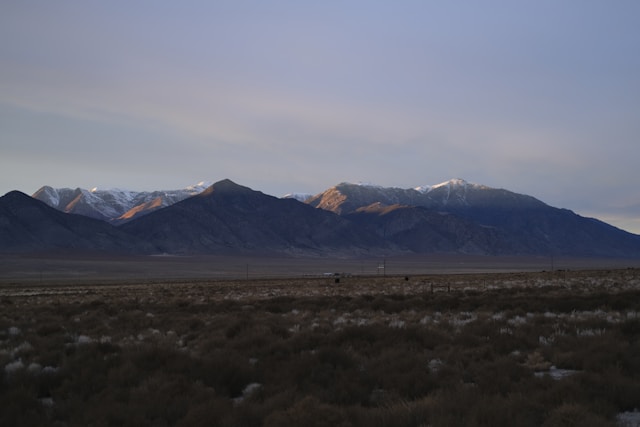
by DGR News Service | May 13, 2024 | ACTION, Mining & Drilling, The Problem: Civilization
BY KATIE FITE / COUNTERPUNCH
A recent financial Webinar features Jindalee mining company executive Lindsay Dudfield selling the company’s plan for an immense lithium mining project that would tear apart the heart of irreplaceable Sage-grouse habitat at McDermitt Creek in southeast Oregon. Australian miner Jindalee has spun itself off as a US company, just as Lithium Americas did when it formed Lithium Nevada Corporation (LNC) to mine Thacker Pass further south in the McDermitt caldera. This positions the miners for federal loan largesse as they pursue mining destruction of the sagebrush sea. I wrote about the extraordinary McDermitt Creek values at stake, and the damage and habitat fragmentation already inflicted by 70 or so previous Jindalee exploration drilling sites here.
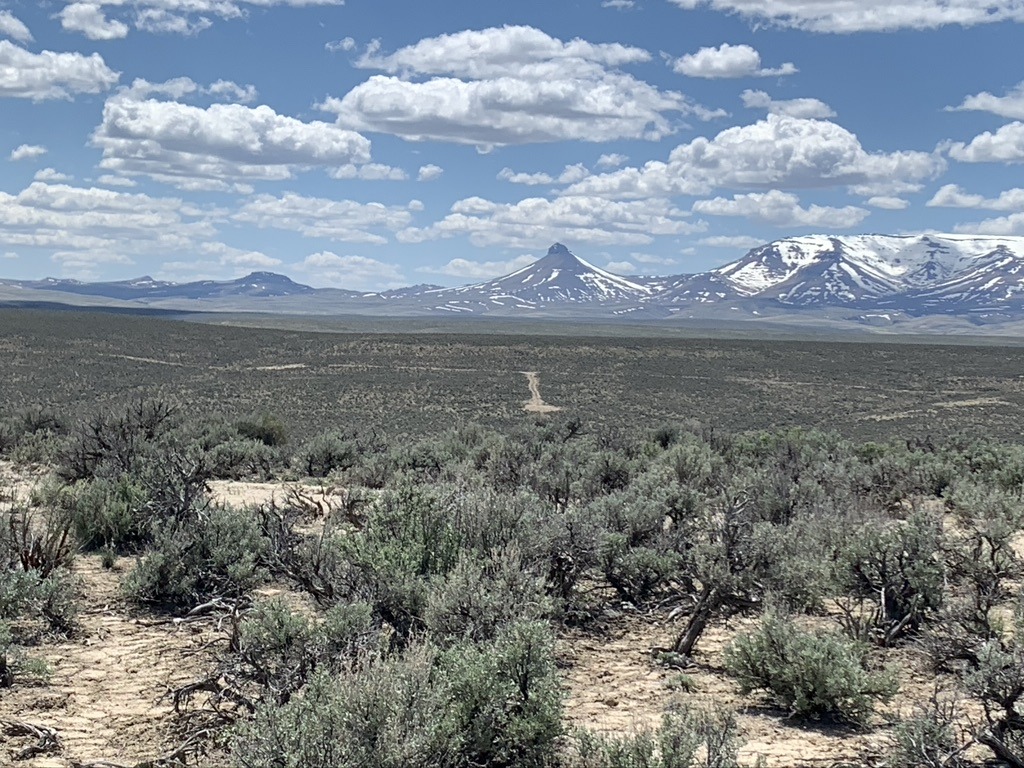
Distant view of scar from a new road and just one of Jindalee’s past McDermitt drill sites. Look at how wide open and unencumbered by hills this country is – maximizing the distance any mining disturbance sights and sounds will travel.
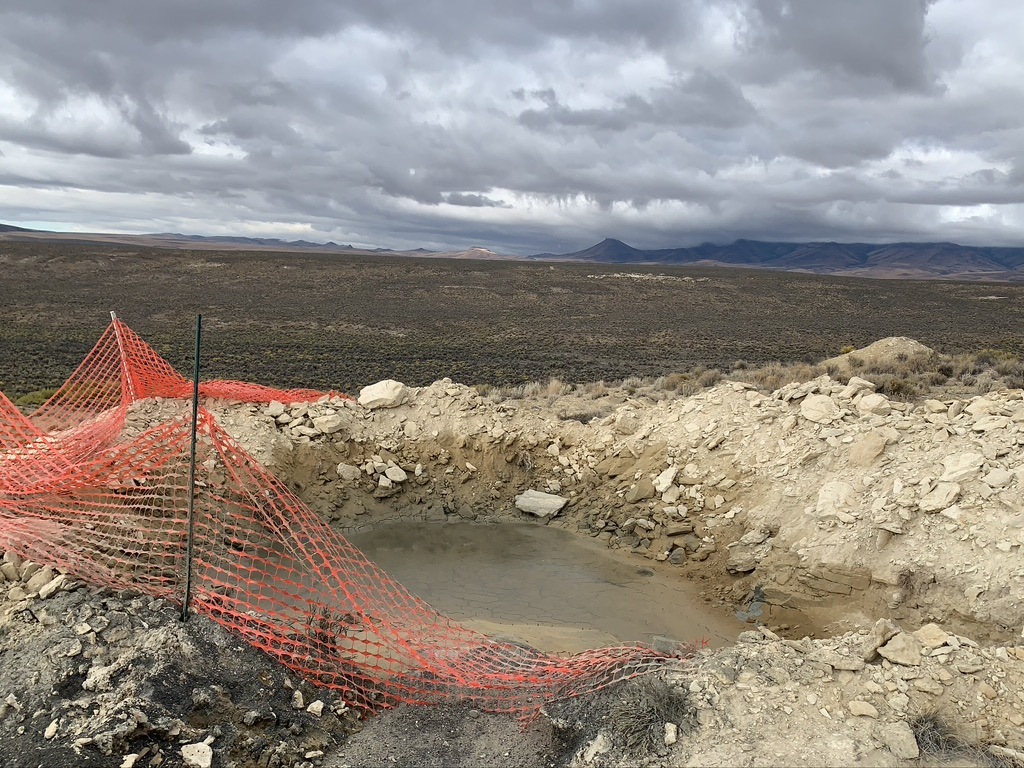
Jindalee drill hole sump. Drilling waste water left to seep into the ground, Wildlife “exclusion” fence fallen down.
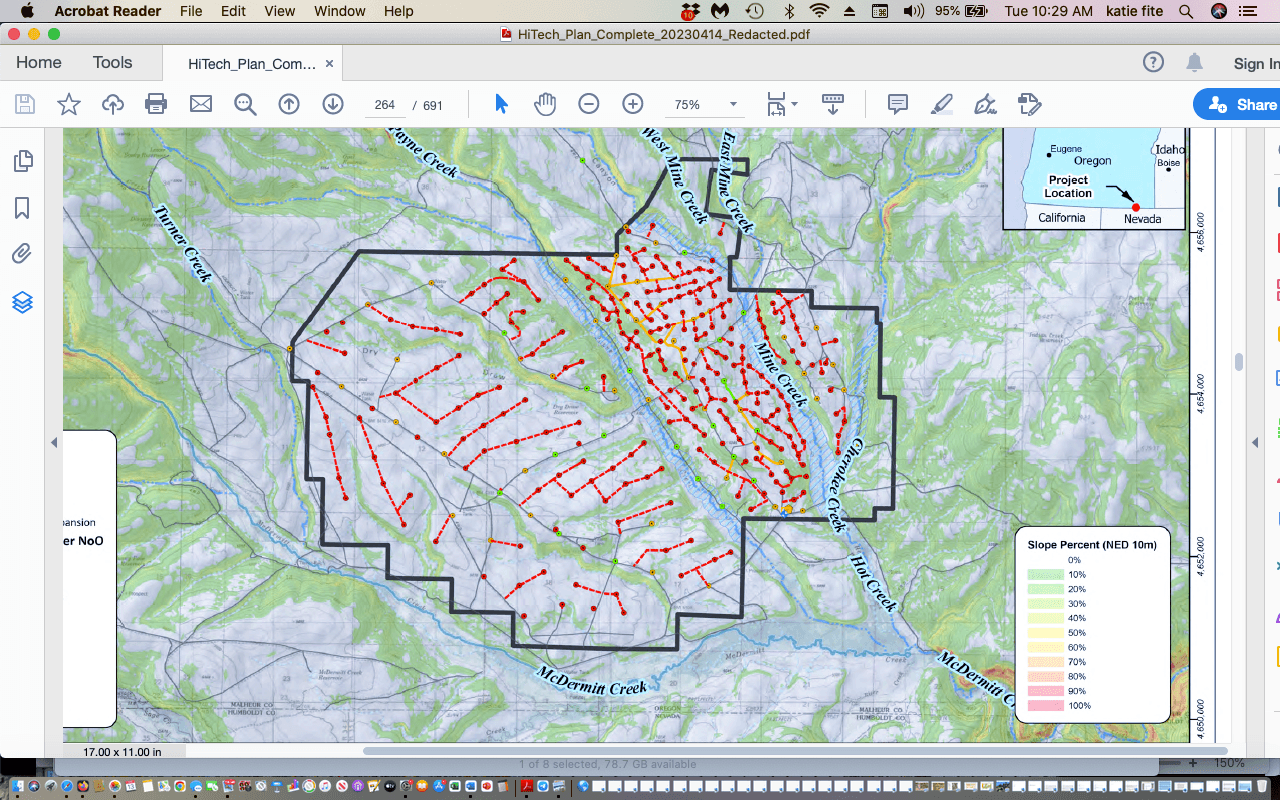 This is a map of the ghastly 2023 Jindalee exploration plan to punch in 267 new drill hole and sump sites and construct 30 miles of new roads. It would fragment an area with a very high density of nesting sagebrush songbirds of all kinds. Birds like Sagebrush Sparrow require continuous blocks of dense mature or old growth big sagebrush. Jindalee boasts its consultant environmental and cultural studies have found “no show-stoppers” and “no red flags”. Industry gets the results it wants when it pays for mine consultant work. Federal and state agencies, after a bit of pro forma sniping, acquiesce to what the mine comes up with.
This is a map of the ghastly 2023 Jindalee exploration plan to punch in 267 new drill hole and sump sites and construct 30 miles of new roads. It would fragment an area with a very high density of nesting sagebrush songbirds of all kinds. Birds like Sagebrush Sparrow require continuous blocks of dense mature or old growth big sagebrush. Jindalee boasts its consultant environmental and cultural studies have found “no show-stoppers” and “no red flags”. Industry gets the results it wants when it pays for mine consultant work. Federal and state agencies, after a bit of pro forma sniping, acquiesce to what the mine comes up with.
No red flags? Does the company really expect us to believe they or their consultants aren’t aware of the plight of Sage-grouse, and the importance of the stronghold habitat they would wipe out? The 2015 BLM Sage-grouse plan found the entire McDermitt Creek area and nearly all caldera lands were essential for the bird’s survival. BLM determined that a federal mineral withdrawal was necessary to protect this Focal habitat and to ensure Sage-grouse species survival. The withdrawal never happened, stopped first by mining and cattle industry litigation. BLM then began a stand-alone NEPA analysis for the withdrawal. Trump terminated that withdrawal analysis process. Then after a court ruled his action unlawful, BLM foot-dragging has stalled the most recent withdrawal process at the NEPA scoping stage and it appears merged with a cumbersome major plan revision.
Jindalee’s new exploration proposal – a prelude to a mine – would tragically rip apart the Basin heart. A full blown mine here would obliterate it. Mining noise and visual disturbance emanating outward would make the remaining sage ringing the mine site uninhabitable. The site is surrounded by dozens of leks.
The impossibility of mitigating a mega-mine at McDermitt Creek just blasted further into the stratosphere. Mounting scientific evidence shows how seriously the sight and sound disturbance footprint of industrial projects harms the birds. New research examined geothermal energy development impacts from Ormat plants at Tuscarora Nevada and McGinness Hills/Grass Valley near Austin. (I remember the Battle Mountain BLM manager extolling Ormat’s virtues when the McGinness project was pushed through and then later expanded to take a bigger bite out of sage habitat). New research found:
“… sage-grouse population numbers declined substantially in years following the development of a geothermal energy plant … sage-grouse abundance at leks [breeding sites] decreased within five kilometers of the infrastructure and leks were completely abandoned at significantly higher rates within about two kilometers. So, we looked at the mechanisms responsible for declines in numbers and lek abandonment, and we found adverse impacts to survival of female sage-grouse and their nests”.
This reinforces common sense: “Nests located farther from the plant tended to experience higher rates of survival. Interestingly, where hills were located between sage-grouse nests and infrastructure [high topographic impedance], we found the distance effect to be less important. Under those circumstances topography was compensating for the lack of distance and likely serving to reduce effects of light and sound”.
“The physical footprint of geothermal energy infrastructure is small relative to other renewable energy … but noise and light pollution emanating from these power plants likely cause larger adverse direct impacts to wildlife populations than infrastructure alone”.
There aren’t big hills to block a lithium mine’s 24 hour a day sight and sound impacts in the McDermitt bowl. The mined area would suffer outright sage obliteration. Surrounding sagebrush would be exposed to unimpeded straight line 24 hour a day mine operation visual impacts and noise of all kinds.
Jindalee must know of the indigenous opposition and resistance to the Thacker Pass lithium mine in the southern caldera, located in similarly unceded Paiute-Shoshone ancestral lands. Controversy and lawsuits over Thacker Pass have been in the headlines for years. It’s a pre-eminent example of an unjust transition to alternative energy and the green-washing of air and water polluting habitat wrecking dirty hard rock mining. Unfortunately, a District Court Judge’s ruling did not halt the Thacker Pass mine construction. However, the lawsuits by environmental groups, Tribes and a local rancher opposing the mine continue. The District Court decision was appealed to the Ninth Circuit, where a hearing is scheduled for June 26.
Thacker Pass mine development would destroy a Traditional Cultural Property, where Paiute-Shoshone ancestors were massacred. This spring, it’s been the site of the indigenous Ox Sam Women’s Camp, Newe Momokonee Nokotun, set up in protest. Descendants of Ox Sam, a survivor of a US cavalry massacre at Thacker Pass, helped establish it.
Jindalee Webinar statements also hint at efforts afoot to alter Oregon state mining processes. After lamenting the project wasn’t in Nevada, Jindalee said it was talking to politicians and the head of the state mining Department (DOGAMI).
The company’s braggadocio made me blow off deadlines and go once again to McDermitt Creek to document its great biodiversity values. I then went from the beauty of singing sagebrush songbirds, newly hatched Sage-grouse chicks and peaking rare plant blooms at McDermitt Creek (photos below) and down into the Montana Mountains by Thacker Pass.
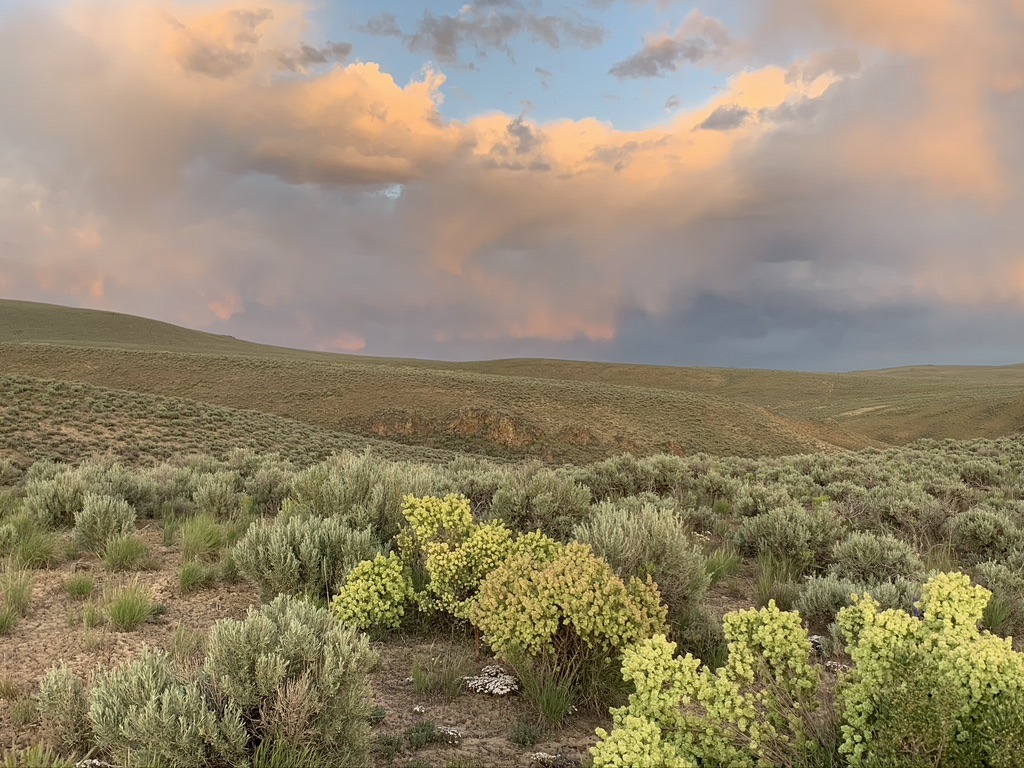

Sagebrush Sparrows abound at McDermitt Creek. They’re great little birds and often sing throughout the day. And they’re vanishing from many places. A biologist just told me he thinks they may be extirpated in Morrow County Oregon where he’s long inventoried bird. No larger continuous blocks of lower elevation sage = no Sagebrush Sparrows.
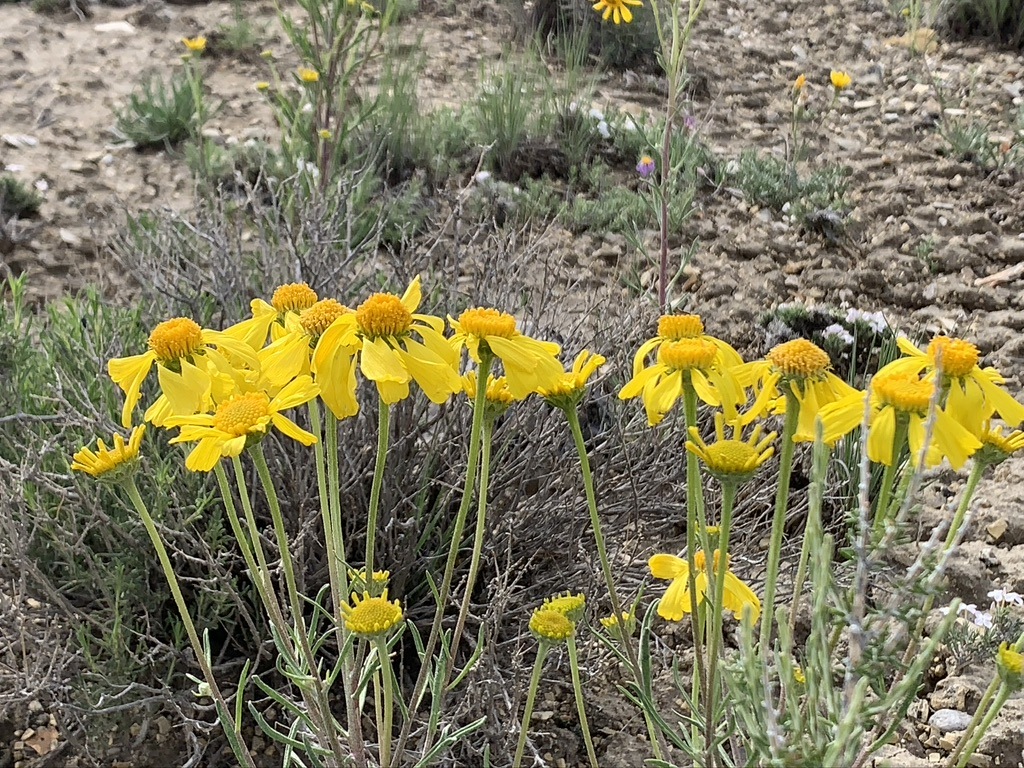
Hymenoxys, an Oregon sensitive plant growing on clay soils.

Humboldt Mountains Milkweed, a medicinal plant, on clay soils.

Mountain Bluebird.
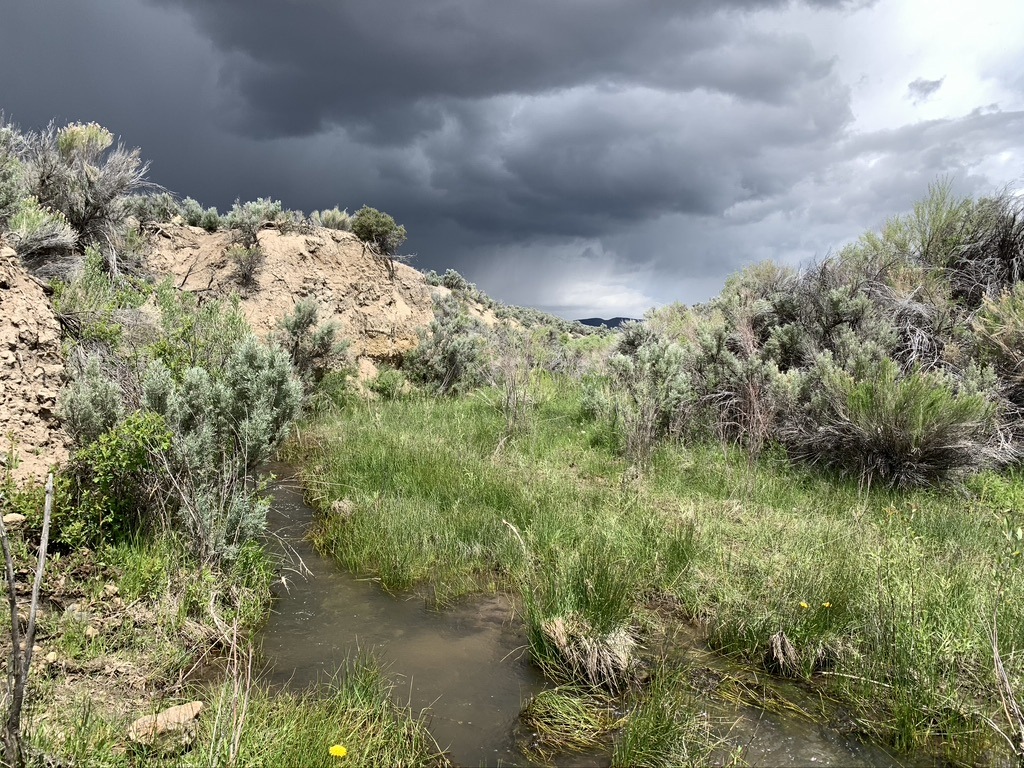
Sky drama all spring long.

Short-horned Lizard – a master of invisibility.

Gray Flycatcher. They nest in head high Basin big sagebrush, which is becoming as scarce as hen’s teeth.

Lark Sparrow. They’re exuberant singers and are dining on Mormon crickets at McDermitt Creek.

An indescribable Indian paintbrush hue.
We’re supposed to sit back and let all this beauty and biodiversity be destroyed for a lithium mine? No way.
Thacker Pass – Turmoil, Land Mutilation, Montana Mountains
I drove south to Orovada and headed west to the turn-off from the state highway into Pole Creek road, the main access to the Montana Mountains. Thacker Pass lies at the southern base of these mountains. A maroon Allied Security company truck squarely blocked the road. Chain link fencing with No Trespassing and No Drone Zone signs was placed off to both sides.
 I stopped, got out and approached a security guard who appeared at the truck. He refused to let me pass. After several minutes of my insistent repetition that this was a public road, the BLM mine EIS said this road would always be open, and that blocking use of this road indicated the EIS, the BLM and Lithium Americas had lied, the security guard relented and said he would call the head of security.
I stopped, got out and approached a security guard who appeared at the truck. He refused to let me pass. After several minutes of my insistent repetition that this was a public road, the BLM mine EIS said this road would always be open, and that blocking use of this road indicated the EIS, the BLM and Lithium Americas had lied, the security guard relented and said he would call the head of security.
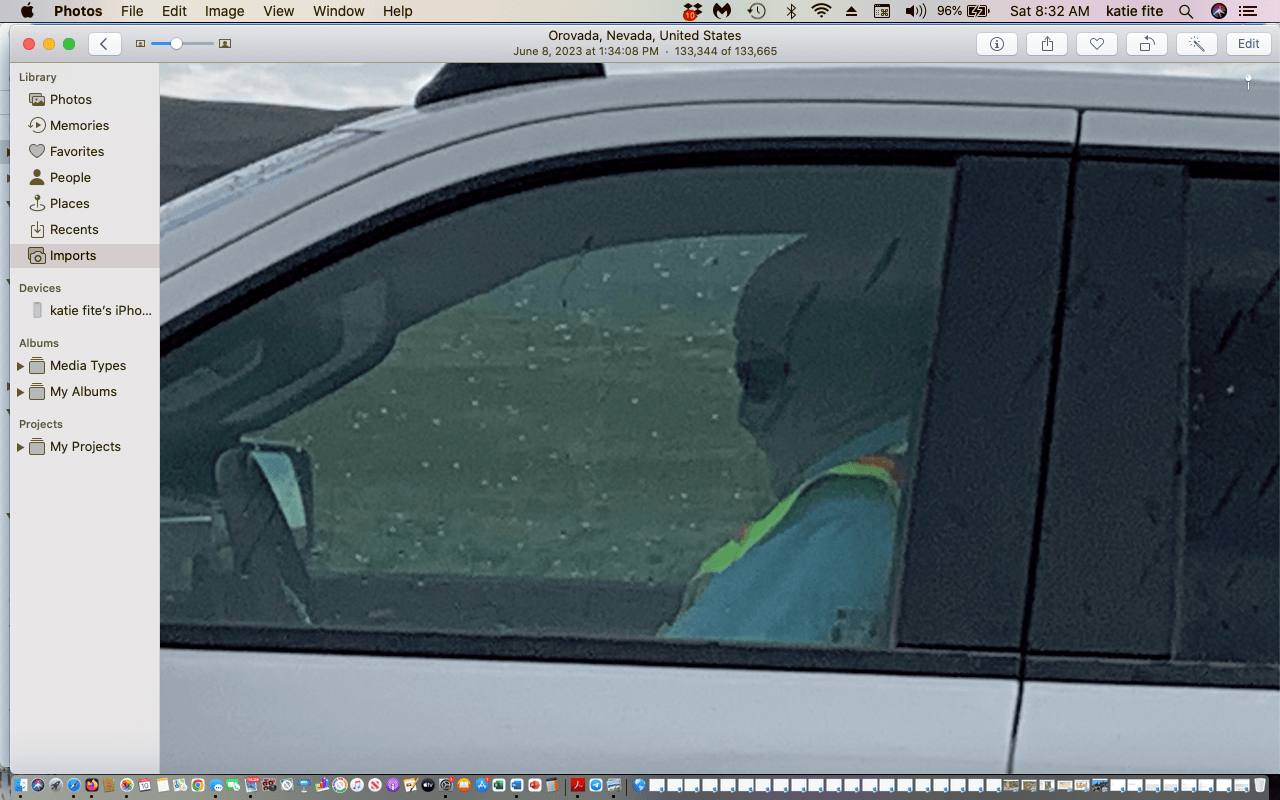 The boss pulled up in a white truck as a sudden rain whirlwind bore down. His face was obscured, and identity concealed by a tan balaclava-like hood and dark sunglasses. When he first arrived, he got out of his truck and pointed a camera device at me. I thought WTF is this – a security firm mercenary decked out for Operation Iraqi Freedom? Abu Ghraib in Orovada? I again repeated repeatedly that this was a public access road, and I was going up into the Montana Mountains to camp. He retreated to his pickup, likely to run me and my license plates through some creepy database. Finally, I was allowed to pass through.
The boss pulled up in a white truck as a sudden rain whirlwind bore down. His face was obscured, and identity concealed by a tan balaclava-like hood and dark sunglasses. When he first arrived, he got out of his truck and pointed a camera device at me. I thought WTF is this – a security firm mercenary decked out for Operation Iraqi Freedom? Abu Ghraib in Orovada? I again repeated repeatedly that this was a public access road, and I was going up into the Montana Mountains to camp. He retreated to his pickup, likely to run me and my license plates through some creepy database. Finally, I was allowed to pass through.
Just up the road was the Ox Sam Protest Camp site, located on a huge mine water pipeline gash that the lithium company had gouged into the earth. The pipeline gash runs right by the sacred Sentinel (or Nipple) Rock. The tents appeared lifeless, flaps blowing open in the rain squall as I drove by. With better cell phone service up in the mountains, I called Winnemucca BLM, asked to talk to a Manager, Assistant Manager, somebody, and told the receptionist that the mine was trying to block the public access road. She said there was no one to talk with. I asked for a Manager’s e-mall address. She refused to give me an address and shunted me to the general BLM mailbox where public comments go to be ignored. Winnemucca is the BLM outpost in charge of enforcing LNC’s compliance with EIS requirements. They’ll be sure to jump on enforcement actions when the public brings potential mining violations to their attention over the next 45-years.
Later I saw a Google alert for “Thacker Pass”, and read that the camp had been raided after an incident. Underscore News/Report for America writes: “On Wednesday, police from the Humboldt County Sheriff’s Office and private security for Lithium Nevada, a subsidiary of Lithium Americas, cleared the camp and arrested one protester.
When I left the next day, the chain link fence with No Trespassing signs was still up by the sides of the access route. The security truck was gone, and I drove on through. A local resident pulled up. We chatted, gazing up at the mountains that were witnessing the lithium mine destruction unfold. He knows the country like the back of his hand. He said you could see over 20 mountain ranges from the Montanas. Our presence generated the interest of security guards who came by to check us out as we stood by the state road right of way. A project worker came and moved the chain link fence with its No Trespassing signs away – at least for now.
Allied Security’s aggressive approach to security has gained notoriety. The Denver city council canceled their contract after two Allied guards beat a black man so hard they caused him permanent brain damage. In May, Time magazine profiled a long troubling history of Allied incidents.
How fitting. Lithium Americas came in claiming Thacker Pass was some kind of great “green” mine, as cover for plain old dirty open pit mining and a noxious lithium processing plant. Now they’ve hired a security firm prone to violence. I don’t know what went down with the Ox Sam camp. But I do know that having the security boss decked out in black ops head gear is an effort to intimidate, and an indication the security firm may have things to hide. Security personnel concealing their identity or playing gatekeeper on a public lands access road in this way have no place at a project on public lands. Months before the Ox Sam camp was set up, LNC had established a manned compound with a building and fencing and what looked like cameras right by the Pole Creek access road. Driving up into the mountains in April to trek across the snow to the Montana-10 lek had already felt like running a gauntlet. I wager that anyone going in or out that public road gets recorded.
LNC has many mining claims staked up in the mountains in Sage-grouse stronghold habitat including at the Montana 10 lek. This makes efforts to limit access or intimidate people so they don’t go up there more concerning. Back home, I consulted the Thacker Final EIS:
“SR 293, Pole Creek Road, Crowley Creek Road and Rock Creek Road are the main transportation routes in the Project area. Under Alternative A, LNC would not close, block, or limit in any manner access along these routes”. FEIS at 494-495. The EIS also constrained use of these access roads for certain types of mine activities.
Photos below from up in the Montana Mountains looking down on spring 2023 LNC scars from drilling and bulldozing in migratory bird nesting season. The drilling is creeping upslope. It’s hard to tell if some may be outside the project boundary. Nevada BLM uses in-front-of-the-bulldozer bird survey protocols that are deeply flawed with transects spaced 100 ft. apart – a distance far too wide to detect cryptic sagebrush birds that are experts at concealment. You practically have to step on or by a nest to detect it. The only way to avoid migratory bird “take” is for the mine to not destroy the bird habitat in spring.
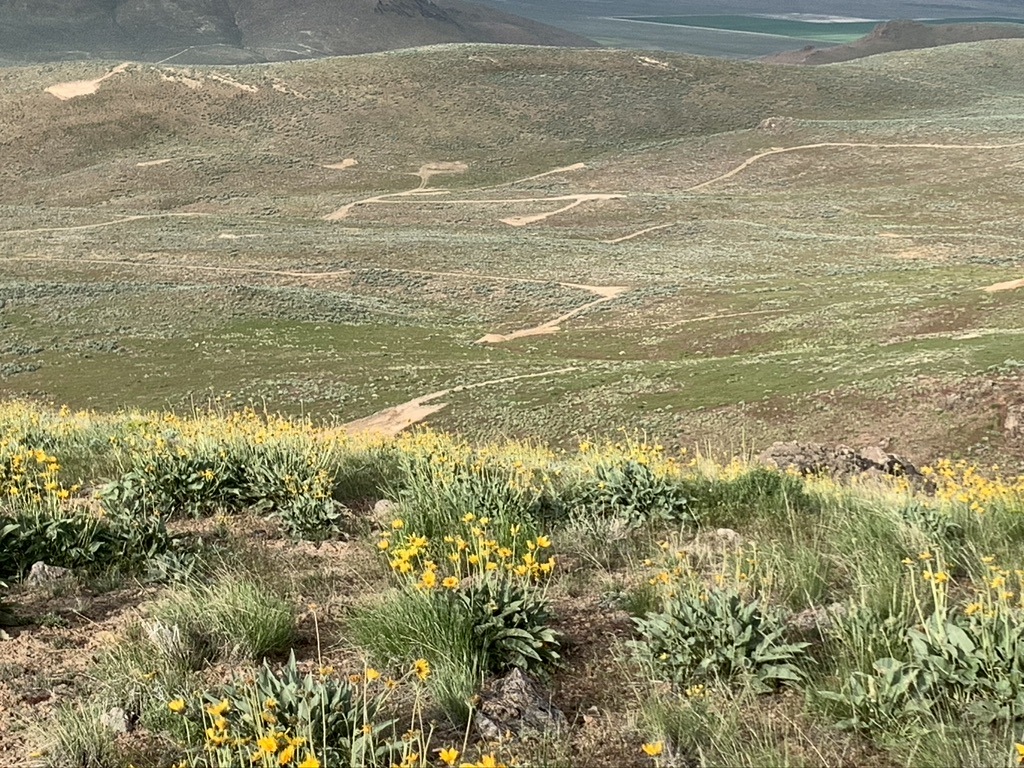
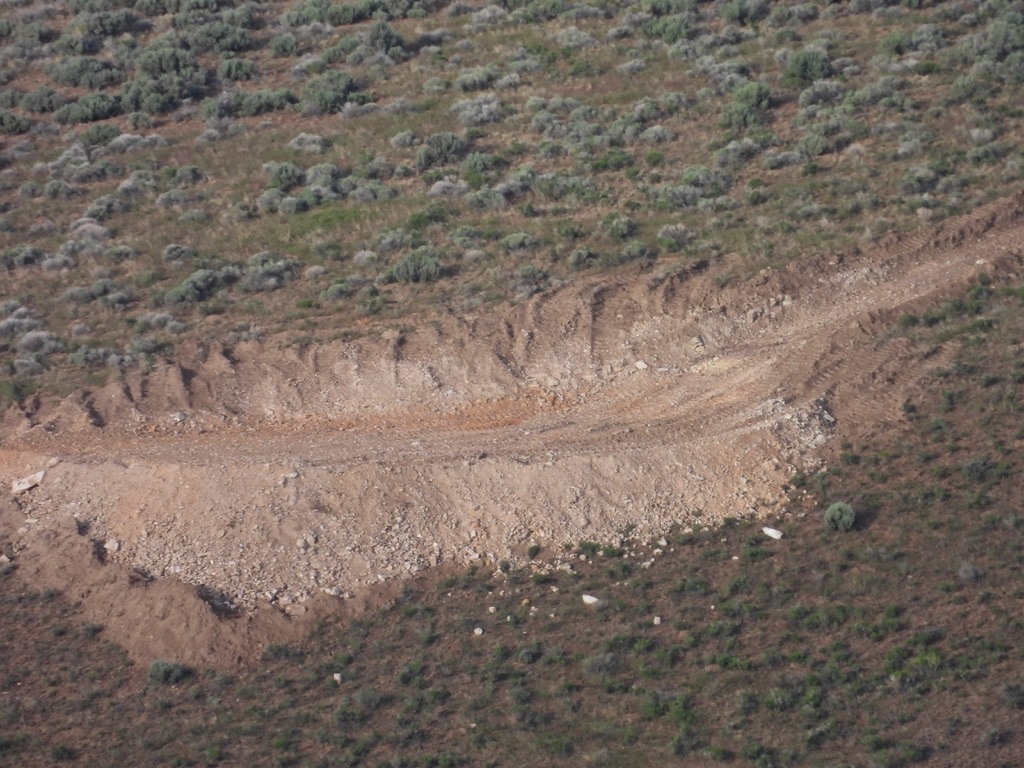
 LNC’s drill scarring is a mere prelude to the destruction that’s planned – 5,694 acres of outright destruction in a 17,933 acre project zone. The enormity and scale of the planned mine is mind boggling – a deep open pit, a waste rock pile, all types of infrastructure, a lithium smelter/sulfuric acid plant on-site using huge volumes of waste sulfur shipped into a new railroad off-loading site by the Winnemucca airport. The latter was just announced a few months ago, to the dismay of nearby residents who find themselves facing living by a hazardous materials zone. Hundreds of tons of off-loaded material will be trucked to Thacker Pass and burned every day in a plant whose air scrubber design wasn’t even finalized before the Thacker decision was signed by BLM. What stink and toxic pollution will this lithium processing generate? McDermitt caldera soils contain uranium and mercury. Mine water use is estimated to be 1.7 billion gallons annually. Enormous volumes of diesel fuel will be used throughout the mine’s operation. What’s green about all this?
LNC’s drill scarring is a mere prelude to the destruction that’s planned – 5,694 acres of outright destruction in a 17,933 acre project zone. The enormity and scale of the planned mine is mind boggling – a deep open pit, a waste rock pile, all types of infrastructure, a lithium smelter/sulfuric acid plant on-site using huge volumes of waste sulfur shipped into a new railroad off-loading site by the Winnemucca airport. The latter was just announced a few months ago, to the dismay of nearby residents who find themselves facing living by a hazardous materials zone. Hundreds of tons of off-loaded material will be trucked to Thacker Pass and burned every day in a plant whose air scrubber design wasn’t even finalized before the Thacker decision was signed by BLM. What stink and toxic pollution will this lithium processing generate? McDermitt caldera soils contain uranium and mercury. Mine water use is estimated to be 1.7 billion gallons annually. Enormous volumes of diesel fuel will be used throughout the mine’s operation. What’s green about all this?

Think of the volume of water that will be sucked through these pipes.
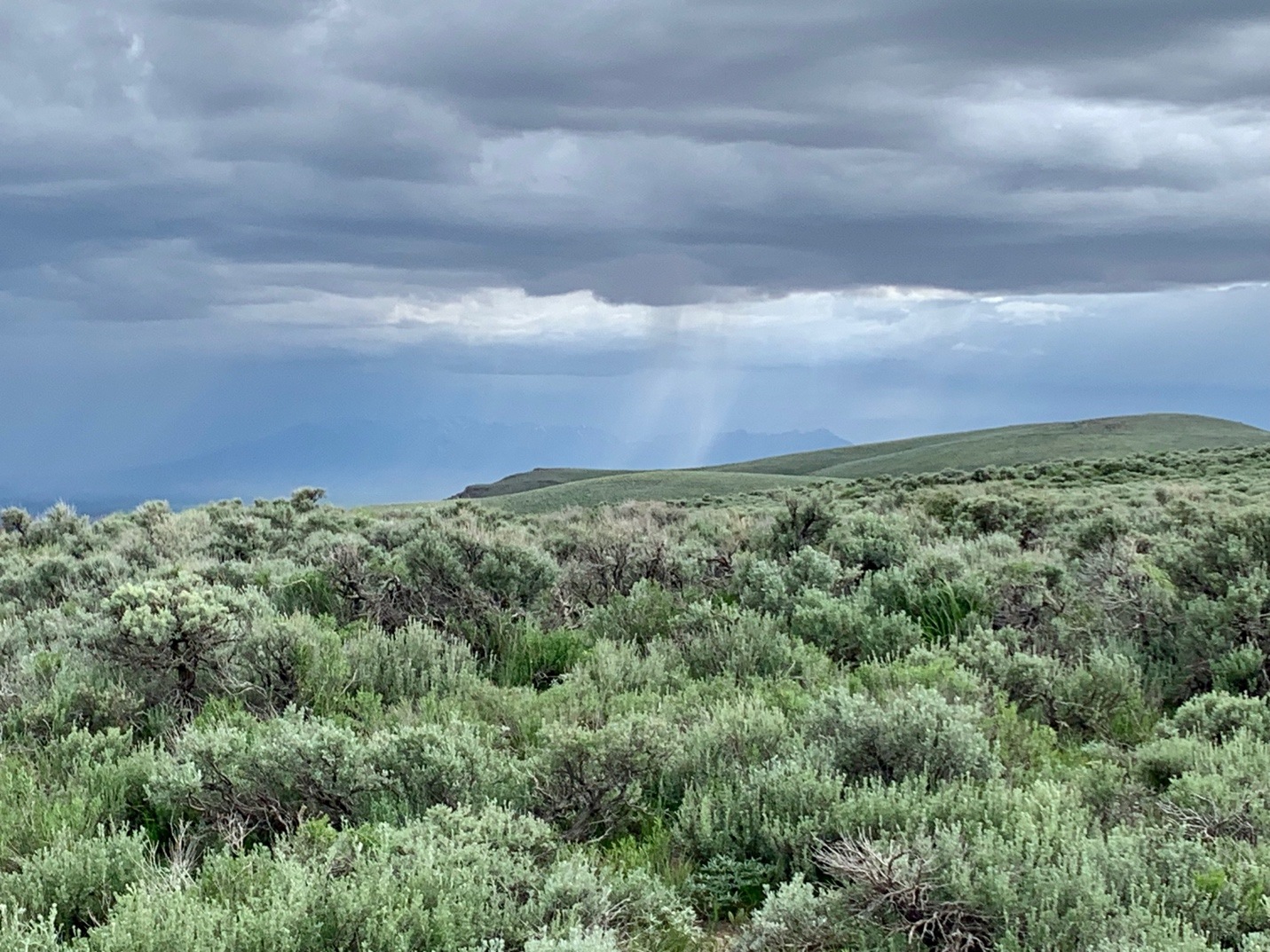
Beautiful dense big sagebrush full of Sage Thrashers, Brewer’s Sparrows, and Sage-grouse sign, up in the mountains where LNC has claims galore.
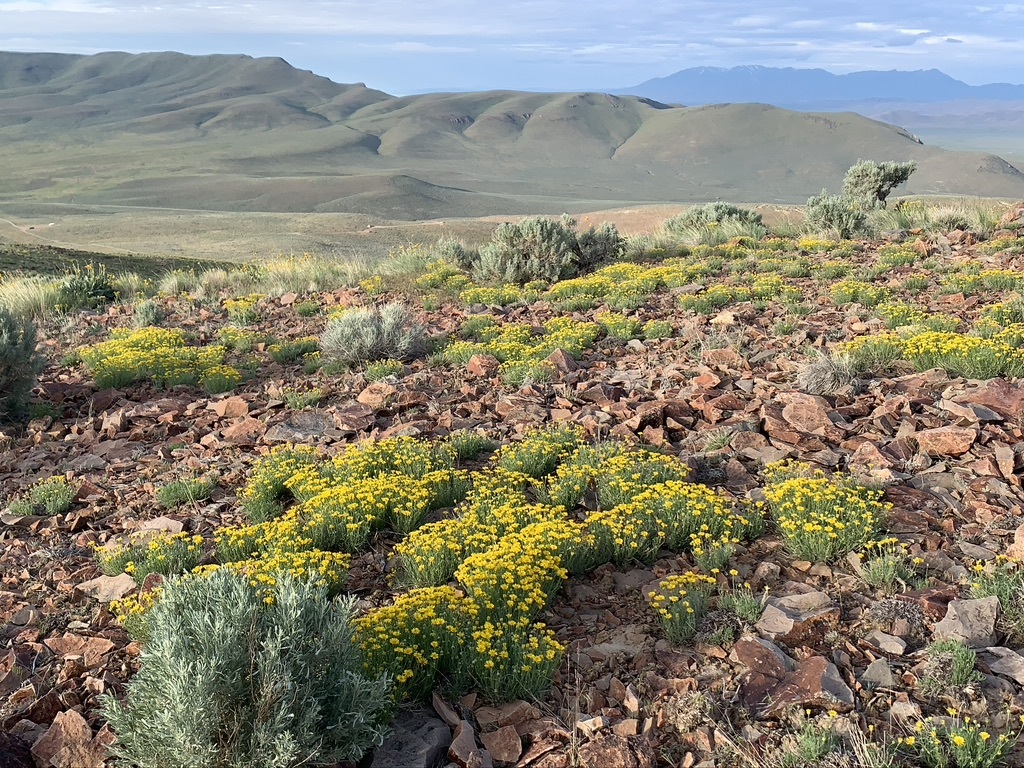
 Sacrificing the Interior West for Corporate Energy Dominance While Energy Conservation Lags or Is Forgotten Altogether
Sacrificing the Interior West for Corporate Energy Dominance While Energy Conservation Lags or Is Forgotten Altogether
Big Green environmental groups and outdoor interests who’ve been silent on the unfolding lithium mine destruction at Thacker Pass, or the tragic destruction of Mojave Desert Tortoise habitat for Big Solar and many other brewing “green” energy controversies better wake up. The lithium boom plague that’s descended on the West is hard rock mining at its worst. Thousands of acres at each mine site become essentially privatized (with security guards) for 40 or 50 years. Much of the land is reduced to waste rock rubble piles, gaping pits, infrastructure all over the place. Local water is used up for processing and for suppressing clouds of dust, and mine pollutants contaminate the air and ground water.
US taxpayers are helping finance these colonialist lithium mines. LNC received commitments for a $600 million dollar loan investment of US tax dollars. General Motors, while continuing to pump out gargantuan trucks and EV Hummers priced at $110,000, provided LNC with a $600 million dollar injection. In the Jindalee Webinar, executive Dudfield assured a questioner that their company will also be “in queue” for similar handouts. The miners are gobbling up funds for a battery technology that may soon be outdated. China is zooming past the US with its development of sodium batteries and is introducing them in low-end vehicles, a sane path forward. Why aren’t these funds going to research alternatives to lithium and safer less earth-wrecking technologies? Why isn’t Nevada Senator Catherine Cortez-Masto directing her attention to spurring new technologies and sustainability? Instead she’s using “critical minerals” mantra to justify introducing a bill to make the 1872 Mining Law even worse, and a wholesale giveaway to mining companies.
Jindalee’s Webinar talk said the company embraced “social license and responsibility”, then later emphasized that McDermitt Creek was “a long, long way” from Oregon population centers like Salem and Portland. This highlights how lithium mine pollution, cultural site desecration, community de-stabilization and ecological damage will be out of sight and out of mind of urban elites.
US government policy is now based on greatly accelerating energy colonialism of all types within our own borders, and especially on willy-nilly sacrifice of the public lands of the Interior West. This allows massively subsidized corporations (often tied to a foreign mothership) and billionaires to retain a chokehold on energy. Conservation is paid lip service. BLM’s Tracy Stone-Manning just announced a new proposed rule making it easier for BLM to hand over public lands to wind and solar developers, furthering de facto public lands privatization for half a human lifespan.
But people are catching on. A surprising thing recently happened in Idaho. The entire Idaho legislature (all the Republicans and the hand full of Democrats alike) voted in favor of a Resolution opposing the BLM Lava Ridge Wind Farm, with its 400 turbines standing 800 feet tall sprawling across 3 counties. Lava Ridge’s plan managed to offend or disgust everybody – from agricultural operations and home site impacts, to Golden Eagle and rare bat killing, to destroying the stark setting of the Minidoka Japanese Internment Camp Monument and marring the Dark Skies and wildness of Craters of the Moon.
The same Legislators, who in a normal year would be inviting Land Grab proponents from Utah to speak in the session, were pushing protection of public lands from this behemoth of LS Power’s subsidiary Magic Valley Energy. It’s facilitated by the planned new LS Power SWIP North renewables-focused transmission line. Idaho Power and PacifiCorp’s Gateway “green” transmission line has also resulted in a stampede for more wind and solar
leases in south-central Idaho.
If you live in the West and love the outdoors, be very afraid of what the Biden administration’s breakneck push for many more of these “green” lines will do to public lands, and your access to areas beyond – once projects feeding energy into the line are built and the fencing goes up. It’s the sagebrush sea equivalent of building a road through the Amazon.
While there are no huge wind farms yet on public lands in Idaho, there are many smaller scale turbine arrays on private lands across the Snake River Plain. It’s become quite apparent that industrial wind is not benign. Above all else, folks realized how badly Idaho was getting screwed by the Lava Ridge project and its export of energy to benefit coastal populations. The Legislature said No to Lava Ridge exploitation of Idaho as an energy colony. Counties in the Mojave Desert are now starting to resist some industrial solar developments overrunning public lands. Remotely sited “renewable” energy or “critical minerals” projects amount to public land privatization. They cause profound losses of many kinds – scarring the land, sucking it dry, extinguishing the wildlife that’s managed to persist in the face of merciless domination since White settlement, trenching a massacre site.
 I’m outraged at the ecocidal stupidity with which this “energy transition” is being carried out. Will we soon see Jindalee get US tax dollars to wipe out the McDermitt Creek Sage-grouse stronghold? How ironic that would be. Interior just announced funding for major sagebrush habitat restoration using Infrastructure Bill funds in High Priority sagebrush areas. It turns out one of the sites chosen is the Montana Mountains area. Mapping shows it includes the Thacker Pass mine area too, where nearly all the sage is on the verge of being destroyed by LNC. Close review of maps for Interior’s Montana “restoration” project shows it encompasses the McDermitt Creek watershed, hence the entire area coveted by Jindalee for massive new drilling followed by open pit mining. It would be absurd to greenlight Jindalee’s ghastly exploration plan in primo habitat, when the Interior Department has identified this very same landscapeto be among the highest priority for restoration – because so much sage has already been lost already. The caldera is also key for connectivity between Sheldon and Owyhee Sage-grouse populations and for biodiversity preservation.
I’m outraged at the ecocidal stupidity with which this “energy transition” is being carried out. Will we soon see Jindalee get US tax dollars to wipe out the McDermitt Creek Sage-grouse stronghold? How ironic that would be. Interior just announced funding for major sagebrush habitat restoration using Infrastructure Bill funds in High Priority sagebrush areas. It turns out one of the sites chosen is the Montana Mountains area. Mapping shows it includes the Thacker Pass mine area too, where nearly all the sage is on the verge of being destroyed by LNC. Close review of maps for Interior’s Montana “restoration” project shows it encompasses the McDermitt Creek watershed, hence the entire area coveted by Jindalee for massive new drilling followed by open pit mining. It would be absurd to greenlight Jindalee’s ghastly exploration plan in primo habitat, when the Interior Department has identified this very same landscapeto be among the highest priority for restoration – because so much sage has already been lost already. The caldera is also key for connectivity between Sheldon and Owyhee Sage-grouse populations and for biodiversity preservation.
How long before rejection of lithium and other “critical mineral” mines grips communities, especially as promised jobs evaporate with increased mine automation and robot technology, and as the environment goes to hell? But hey, as LNC is showing us, there’s always a bright future as a security guard– at least until the lithium company gets itself a pack of Robodogs.
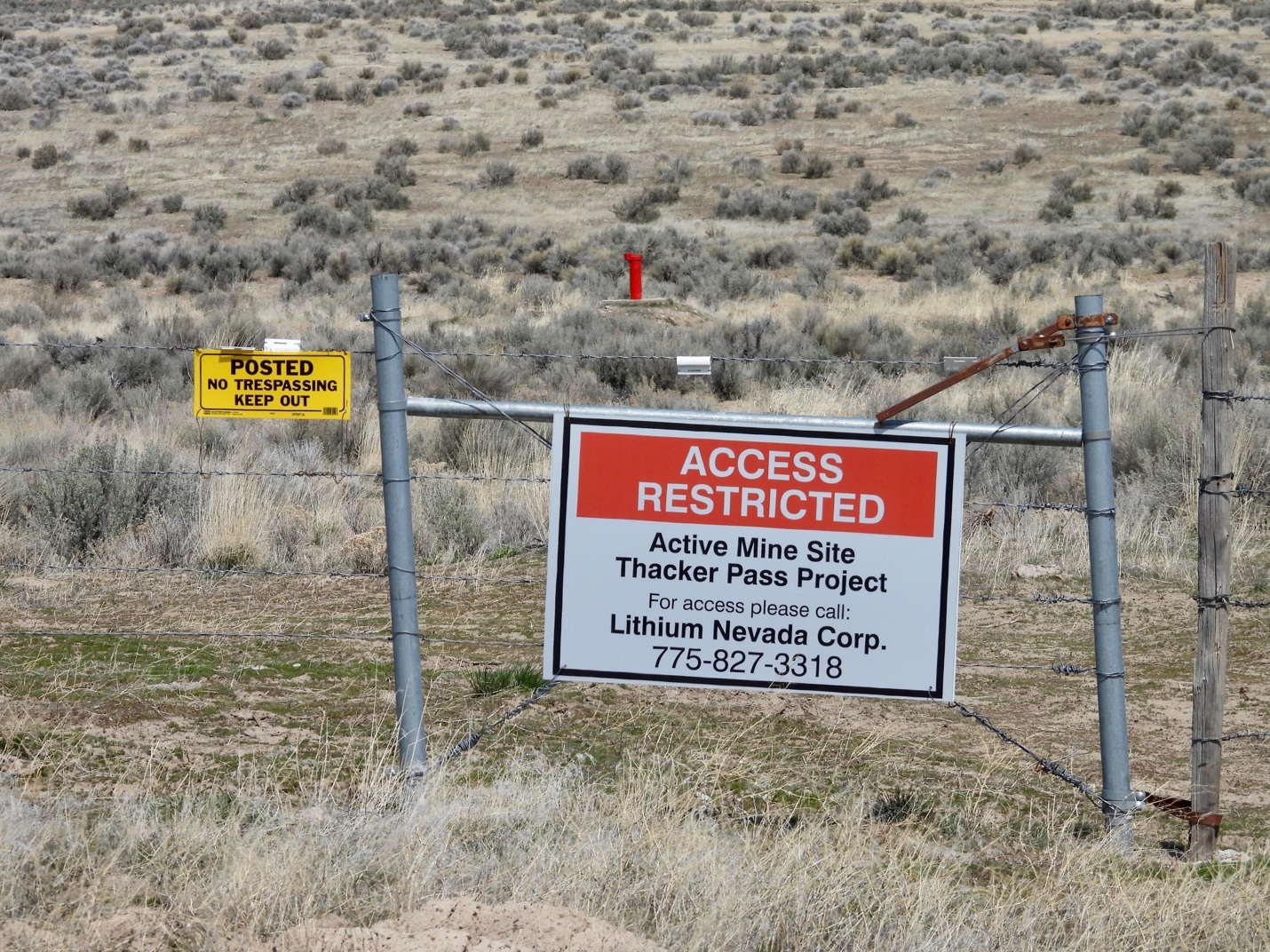
Katie Fite is a biologist and Public Lands Director with WildLands Defense.

by DGR News Service | Nov 3, 2023 | ANALYSIS, Listening to the Land
Editor’s Note: This piece was offered by Austin Persons. He wrote this in the last fall, with a sense of grief over what has been lost in the natural world.
November Falling
By Austin Persons
In this time of transitions deciduous forests glow, rustling softly on the breeze. Leaves, having fed their trees since spring, drift poetically to Earth. They wish to protect the ground which sustains their community, to merge with the infinite in the second half of their lives as leaves.
In the way of November forests, I release ideas that sustain me. They long to be shared, to keep growing, to return to all that made them possible, to take deep purpose in becoming—new forms of action and matter—in the second half of their lives as ideas. From my swaying limbs I shed gratitude and love. Like sunlight and water united, they enlarged my outwardly reaching heart with a new ring of growth. Landing thick now like a blanket over the Earth, love and gratitude embrace the rich humus from which they were born; to protect, to become, and to sustain future generations. And I glow – brilliant red and gold, brown and green against the blue sky. Lines of distinction blur. I am a colorblind rainbow rustling in the soft afternoon breeze, contemplating the coming seasons, imagining new ways of being and becoming.
In the way of November leaves, my thoughts dance through the sky and flutter across the ground searching for purpose, that place where they alone can fit; in the embrace of kin on the slow journey back to the Source. Leaves and thoughts, one and the same, scrape over the homogenous landscape of progress. They mourn. They want nothing more than to cover these forsaken places thickly under a blanket of love, but it is hard to settle on concrete and asphalt. They shudder at the thought of being swept up, bagged and buried in a landfill; discarded, rendered purposeless among countless precious gifts from our Mother. So they keep moving, grieving the loss of timeless living legends, irreplaceable works of art – sacrificed without cause for someone’s short-sighted delusions of wealth.
I wonder what messages these leaves carry, where they will settle, and how they will council once all have arrived. Could the wild leaves understand what they had never seen, could the civilized leaves see beyond what they had always known? My wild and civilized thoughts wrestle when they meet, they hardly speak the same language. Their greatest desire, however, is to find common ground; a place worth settling, a reason to decay into something greater than one among kin of every shape and color. I wonder if it is not so among the falling leaves.
I find myself grieving, searching along with the leaves, wondering whether I will be able to fulfill my duties or be rendered purposeless; buried in a heap of waste that once was wealth.
Like time, leaves and thoughts circle; narrowly, broadly, remembering, forgetting, creating, destroying, uniting darkness and light. White expands across the spectrum of possibility through the prism of thought, I search for answers on the margins of perception.
I ask the wind to carry my love and gratitude to Life, to the Ancestors, along with a plea for help. I tell them of the crusades against their legacy, of violence against present and future generations perpetrated by those who claim to be our leaders. I beg the Ancestors on behalf of Life to intervene. Whisper in our ears, show us visions when we close our eyes, guide us down the faintest of paths in the dimmest of light. Help us remember our place, and to know the way there. For I want to honestly embrace Life—long and warm—look deeply into her eyes and say without speaking: I promise to love you forever.
As a swift gust of wind paints the evening sky, the forest erupts with song and dance.
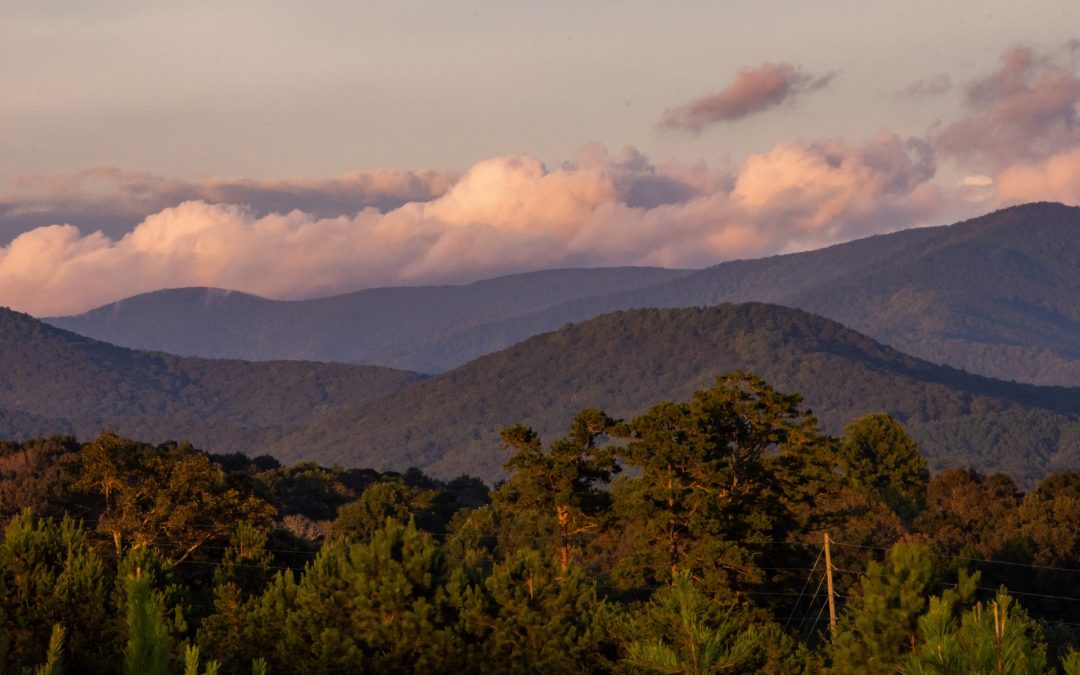
by DGR News Service | May 8, 2023 | ANALYSIS, Listening to the Land, Movement Building & Support
Editor’s Note: It is not enough to consider short-term productivity when we talk about restoration of the natural world. It is imperative that we talk about how the landscape will be in the future, hundreds, maybe thousands, of years from today. Only then will we be talking about true sustainability, or about true restoration.
By Austin Pearsons
Our actions today determine our options tomorrow. This is as good a time as any to ask ourselves hard questions. To look around, to look inward. How are our choices impacting future generations? What will be our legacy? Will the children of tomorrow benefit from our actions today? Will our grandchildren thank us for our dedication and foresight? Our grandchildren’s grandchildren? Will there be abundance or will there be scarcity? The answer hinges on us in the present.
Many of our cultural predecessors practiced the seven generation principle or something like it. They recognized that the conditions we inherit in this lifetime have been determined by the actions of those who came before us; from seven generations ago until now. They acknowledged that the decisions made today reach far into the future; affecting those yet unborn for seven generations (there are many interpretations). Today we are imperiled by widespread pollution, water contamination, chronic inflammatory diseases, global pandemics, escalating rates of deforestation, extinction and biodiversity loss, ocean acidification and collapsing fish stocks, massive uncontrollable wildfires, insect and diseases outbreaks decimating forests, loss of soil fertility paralyzing our global agricultural systems, food insecurity, sea level rise, climate chaos, flooding, drought, inflation, debt, war, and on and on and on. This is the legacy of our ancestors which we have inherited. I often wonder if we will last seven generations more.
If we are to secure a livable future for the generations to come, we must adjust our way of thinking, acting, and being. The solutions to the crises we face are less complex than we are often led to believe. Let’s break it down. Pollution, biodiversity loss, and climate change are our big problems to solve. In solving them, we can address every related problem of our time (governmental corruption, corporate greed, and media collusion are beyond the scope of this analysis).
I cannot claim to be a global expert so I will stick to what we can do right here in Appalachia which can, in fact, go a long way towards resolving global challenges. It is worth noting that Appalachia is the largest temperate deciduous forest on earth, among the most biodiverse regions on the continent of North America (and the world). A resilient forest that once stretched, nearly unbroken, from the Mississippi River to the Atlantic Ocean, from the Gulf of Mexico to Quebec. The chestnuts, chinquapins, oaks, hickories, walnuts, hazels, maples, countless species of berries and tree fruits, roots, herbs, fish and game provided abundant proteins, carbohydrates, fats, sugars, nutrients, and medicines to the indigenous peoples who were inseparable co-creators of the forests. Some peoples supplemented their diets with diverse varieties of corn, beans and squash (and other cultivated crops) as well. They did this all without factories, steel, internal combustion engines, chemical fertilizers, pesticides, plastics, fossil fuels, electricity, or the internet. The picture I am painting is of a landscape unfragmented by cities, suburbia, fences, and roads, where water was clean enough to drink, where ancient trees freely gave hundreds, often thousands, of pounds of food to any and all year after year for centuries on end with no need to fertilize, till, spray, or tax – all while improving soil fertility, sequestering carbon and protecting water quality. Food was always close at hand: no need to ship it from California, Mexico, Indonesia or Brazil. Medicine was freely available to those who were sick. Clothing, canoes, string, sealant and shoes grew on trees, in wetlands and fields – even walked about on four legs. The forests were chemists and cooks, providers of heat, they built homes, insulated, and illuminated them too. When I consider these things, I question the wisdom of our current paradigm.
The way we practice agriculture today is the leading cause of biodiversity loss, deforestation, topsoil erosion, and the largest emitter of greenhouse gasses globally. The methods are efficient by some standards and the food produced is calorically rich, perhaps, but nutritionally poor and loaded with poison. It causes us innumerable health problems such as food allergies, irritable bowel syndrome, tooth decay, obesity, and diabetes. Agriculture, as practiced today separates us from the land, from our food, and causes hopeless dependence on the very systems that are exploiting and polluting our bodies, watersheds, ecosystems, and the planet. Conventional agriculture decreases the genetic diversity of our crop species and decreases the diversity of food that we have access to. If we wanted to stop eating roundup-ready genetically modified corn, soy, and rice, most of us would starve. We argue incessantly over jobs, and obsess over our fitness regimes, but if we took a shovel and a hoe and planted our lawns with food, we would be healthy, wealthy, and wise in no time. If we planted them with chestnuts and cherries, pecans and persimmons, our grandchildren might not face the problems we do.
Locally we farm hay, grains like corn and wheat, and cows on our most productive lands – lands that once supported thousands of plants and animals per acre. The productivity of our local agriculture declines over time as soil fertility washes downslope. Why not apply the principles of regenerative / restoration agriculture, agroecology, or closely related permaculture? The benefits of replacing conventional agriculture with diverse perennial polycultures have been demonstrated all over the world, often in more challenging conditions than those encountered here in Appalachia? Millions now replicate successful strategies worked out by indigenous peoples everywhere and described by: Yeoman, Fukuoka, Mollison, Holmgren, Shepard, Smith, Holzer, Gotsch, and so many more. There are countless documented approaches to growing food that are vastly more productive and resilient than industrial agriculture. If we applied these principles instead, we could grow more (and more nutritionally dense) food per acre, with less inputs, and labor that decreases over time while yields simultaneously increase. Intact forests would sequester carbon while feeding people, improving soil fertility, cleaning our waters and decreasing the forest fragmentation which endangers the irreplaceable biodiversity that defines Appalachia. Most importantly, by reconciling our relation to the land, we take responsibility for the future that our grandchildren will inherit, giving them a chance to prosper in what seems an uncertain and perilous future.
Our forestry paradigm is an extension of industrial agriculture. While it has (arguably) been changing for the better it still looks at forests in terms of dollars and board-feet. More troublesome yet, the benefits from cutting the trees of Appalachia’s forests don’t remain in the area, but line the pockets of far away lumber barons who ship it to distant markets where they have already exhausted their forests. Each timber harvest releases carbon into the atmosphere and disrupts the complex web of life in the soil, exposing it to erosive forces, reducing forest biodiversity above and below ground, and introducing invasive species. Mature forests are more species rich and resilient than those that grow back after logging. Ancient trees are critical genetic banks who carry the wisdom to survive changing climate, insect and disease pressures and who transfer those abilities to future generations. They also support more species of birds, insects, amphibians, reptiles, mammals, fungi, and other plants, produce more food and sequester more carbon than younger trees. It is now known that old trees nurture the young and the weak through the mycorrhizal network that connects the entire forest. When we harvest the biggest and healthiest trees in the forest, we destroy the communication and support network that is hidden below ground. Should we not revere the old giants of the forest who have been here longer than us? Should we not offer the wonderment and spiritual presence of old-growth forests to future generations? Should we not learn from their teachings of generosity, reciprocity, persistence, intra- and inter-species cooperation for the good of the whole – for intergenerational prosperity? There is great wisdom in the soil, in the forest community, and if we are wise we will pay close attention.
If you believe that there is a better way, I assure you that you’re right. If you feel powerless to do anything about it, you are not alone, but you are incorrect. We can all make small adjustments to our lifestyles, paying attention to the choices we make each day. Collectively, such actions can make a difference, but it will not be enough if we do not affect larger systems change. There is much we can do to protect what little remains and to restore what has been lost, but we must come together. We must take responsibility for the future, we must shift our perspective, we must collaborate. This human-centered, narcissistic, capitalistic, punitive, infinite growth paradigm that we have inherited is unsustainable, unethical, and unintelligent. I believe that we have the capacity to do good work for the benefit of the whole. But first, we need to shift our consciousness to an ecocentric worldview that removes humans from the hierarchy and places us in a circle with the rest of life on earth. If you agree, let’s get to work. Together we can achieve what is impossible alone.
We are a diverse group of people in every season of life with different skills and assets that are significantly greater than the sum of parts. Linked by a common past and future – like an old-growth forest – ancient mother-trees carry wisdom, access deep water and scarce resources that the young, weak, and sick need to survive. They share through an unseen network so that when the storm brings down the tallest tree, others are prepared to take their place. The individual lives on through others so long as the forest remains intact. So it shall be with us, the visionaries and change-makers. We who give freely of ourselves to ensure that tomorrow is more abundant than today.
Photo by Abigail Ducote on Unsplash


 This is a map of the ghastly 2023 Jindalee exploration plan to punch in 267 new drill hole and sump sites and construct 30 miles of new roads. It would fragment an area with a very high density of nesting sagebrush songbirds of all kinds. Birds like Sagebrush Sparrow require continuous blocks of dense mature or old growth big sagebrush. Jindalee boasts its consultant environmental and cultural studies have found “no show-stoppers” and “no red flags”. Industry gets the results it wants when it pays for mine consultant work. Federal and state agencies, after a bit of pro forma sniping, acquiesce to what the mine comes up with.
This is a map of the ghastly 2023 Jindalee exploration plan to punch in 267 new drill hole and sump sites and construct 30 miles of new roads. It would fragment an area with a very high density of nesting sagebrush songbirds of all kinds. Birds like Sagebrush Sparrow require continuous blocks of dense mature or old growth big sagebrush. Jindalee boasts its consultant environmental and cultural studies have found “no show-stoppers” and “no red flags”. Industry gets the results it wants when it pays for mine consultant work. Federal and state agencies, after a bit of pro forma sniping, acquiesce to what the mine comes up with.









 I stopped, got out and approached a security guard who appeared at the truck. He refused to let me pass. After several minutes of my insistent repetition that this was a public road, the BLM mine EIS said this road would always be open, and that blocking use of this road indicated the EIS, the BLM and Lithium Americas had lied, the security guard relented and said he would call the head of security.
I stopped, got out and approached a security guard who appeared at the truck. He refused to let me pass. After several minutes of my insistent repetition that this was a public road, the BLM mine EIS said this road would always be open, and that blocking use of this road indicated the EIS, the BLM and Lithium Americas had lied, the security guard relented and said he would call the head of security. The boss pulled up in a white truck as a sudden rain whirlwind bore down. His face was obscured, and identity concealed by a tan balaclava-like hood and dark sunglasses. When he first arrived, he got out of his truck and pointed a camera device at me. I thought WTF is this – a security firm mercenary decked out for Operation Iraqi Freedom? Abu Ghraib in Orovada? I again repeated repeatedly that this was a public access road, and I was going up into the Montana Mountains to camp. He retreated to his pickup, likely to run me and my license plates through some creepy database. Finally, I was allowed to pass through.
The boss pulled up in a white truck as a sudden rain whirlwind bore down. His face was obscured, and identity concealed by a tan balaclava-like hood and dark sunglasses. When he first arrived, he got out of his truck and pointed a camera device at me. I thought WTF is this – a security firm mercenary decked out for Operation Iraqi Freedom? Abu Ghraib in Orovada? I again repeated repeatedly that this was a public access road, and I was going up into the Montana Mountains to camp. He retreated to his pickup, likely to run me and my license plates through some creepy database. Finally, I was allowed to pass through.

 LNC’s drill scarring is a mere prelude to the destruction that’s planned – 5,694 acres of outright destruction in a 17,933 acre project zone. The enormity and scale of the planned mine is mind boggling – a deep open pit, a waste rock pile, all types of infrastructure, a lithium smelter/sulfuric acid plant on-site using huge volumes of waste sulfur shipped into a new railroad off-loading site by the Winnemucca airport. The latter was just announced a few months ago, to the dismay of nearby residents who find themselves facing living by a hazardous materials zone. Hundreds of tons of off-loaded material will be trucked to Thacker Pass and burned every day in a plant whose air scrubber design wasn’t even finalized before the Thacker decision was signed by BLM. What stink and toxic pollution will this lithium processing generate? McDermitt caldera soils contain uranium and mercury. Mine water use is estimated to be 1.7 billion gallons annually. Enormous volumes of diesel fuel will be used throughout the mine’s operation. What’s green about all this?
LNC’s drill scarring is a mere prelude to the destruction that’s planned – 5,694 acres of outright destruction in a 17,933 acre project zone. The enormity and scale of the planned mine is mind boggling – a deep open pit, a waste rock pile, all types of infrastructure, a lithium smelter/sulfuric acid plant on-site using huge volumes of waste sulfur shipped into a new railroad off-loading site by the Winnemucca airport. The latter was just announced a few months ago, to the dismay of nearby residents who find themselves facing living by a hazardous materials zone. Hundreds of tons of off-loaded material will be trucked to Thacker Pass and burned every day in a plant whose air scrubber design wasn’t even finalized before the Thacker decision was signed by BLM. What stink and toxic pollution will this lithium processing generate? McDermitt caldera soils contain uranium and mercury. Mine water use is estimated to be 1.7 billion gallons annually. Enormous volumes of diesel fuel will be used throughout the mine’s operation. What’s green about all this?


 Sacrificing the Interior West for Corporate Energy Dominance While Energy Conservation Lags or Is Forgotten Altogether
Sacrificing the Interior West for Corporate Energy Dominance While Energy Conservation Lags or Is Forgotten Altogether I’m outraged at the ecocidal stupidity with which this “energy transition” is being carried out. Will we soon see Jindalee get US tax dollars to wipe out the McDermitt Creek Sage-grouse stronghold? How ironic that would be. Interior just announced funding for major sagebrush habitat restoration using Infrastructure Bill funds in High Priority sagebrush areas. It turns out one of the sites chosen is the Montana Mountains area. Mapping shows it includes the Thacker Pass mine area too, where nearly all the sage is on the verge of being destroyed by LNC. Close review of maps for Interior’s Montana “restoration” project shows it encompasses the McDermitt Creek watershed, hence the entire area coveted by Jindalee for massive new drilling followed by open pit mining. It would be absurd to greenlight Jindalee’s ghastly exploration plan in primo habitat, when the Interior Department has identified this very same landscapeto be among the highest priority for restoration – because so much sage has already been lost already. The caldera is also key for connectivity between Sheldon and Owyhee Sage-grouse populations and for biodiversity preservation.
I’m outraged at the ecocidal stupidity with which this “energy transition” is being carried out. Will we soon see Jindalee get US tax dollars to wipe out the McDermitt Creek Sage-grouse stronghold? How ironic that would be. Interior just announced funding for major sagebrush habitat restoration using Infrastructure Bill funds in High Priority sagebrush areas. It turns out one of the sites chosen is the Montana Mountains area. Mapping shows it includes the Thacker Pass mine area too, where nearly all the sage is on the verge of being destroyed by LNC. Close review of maps for Interior’s Montana “restoration” project shows it encompasses the McDermitt Creek watershed, hence the entire area coveted by Jindalee for massive new drilling followed by open pit mining. It would be absurd to greenlight Jindalee’s ghastly exploration plan in primo habitat, when the Interior Department has identified this very same landscapeto be among the highest priority for restoration – because so much sage has already been lost already. The caldera is also key for connectivity between Sheldon and Owyhee Sage-grouse populations and for biodiversity preservation.








